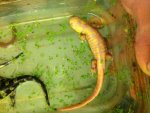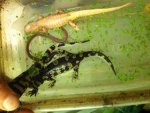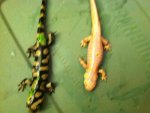Ominojacu
New member
- Joined
- Mar 18, 2013
- Messages
- 56
- Reaction score
- 6
- Points
- 0
- Location
- Maryland, U.S.
- Country
- United States
Hi, I have been a member here for a while and have enjoyed Caudata as a great source of information, but this is my first post. I have kept tiger salamanders for years and have enjoyed them for the wonderful creatures they are, but have never successfully bred them. I am now however committed to this endeavor, as I have recently purchase an albino tiger salamander at a price so obscene for a salamander that my wife cried when I confessed to making the purchase! My goal for this project is to make the albino tiger salamander as common in the hobby as an albino horned frog. So the purpose of this post is to ask for advice and help and in exchange any successful breeding will be made available to Caudata members who are interested. I will of course go through all the old post for information, but if you have any tips or references to post that will save me time, it is much appreciated. My first question is how do identify the exact subspecies that I have? I didn't get much from the seller as far as origin though he was certain that it was not a western species. Secondly, does it matter? I will post pictures soon, thanks!



